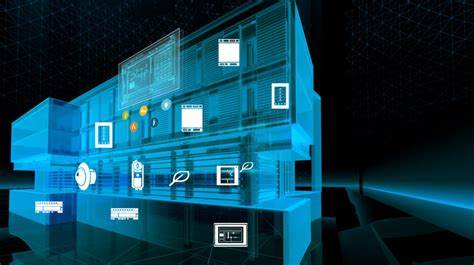Business
Building Automation Systems: What You Need to Know

Automation refers to the process of allowing a control system with sensors, electronics, electric drivers, and programmed logic controllers to conduct tasks that were performed manually previously. Building automation systems do the same function for your own or manage building units.
If you have an organization or live in an apartment building, you can easily assume that this article will provide you with amazing insights.
What is a Building automation system?
Building automation systems (BAS) also known as Energy Management Control System (EMCS) or Building Management System (BMS), are smart devices that pilot HVAC ventilation, fire protection systems, lighting systems, and general building automation.
Imagine returning to a fully automated home where your appliances are activated, your furniture remains in its original position, the lights are illuminated, and the TV presents a flawless view of your front yard that resembles a scene from Parks and Rec. Building automation serves a key function in overseeing equipment, systems, and operations, performing necessary tasks to guarantee their uninterrupted functionality.
How does building automation work?
Building automation systems are purposed to enable the building’s systems to operate automatically and without human intervention. They are commonly applied in installations wherein the residents are either away or interacting with the machines through voice control or digital interface. A BMS can manage every possible feature from lighting and temperature to HVAC, HVAC controls, and other safety-linked capabilities when an individual is absent.
Building automation is a system where transmitters and computers are applied to manage the functions of a building such as controlling lighting in your home, turning on those lights when you enter, cooling or heating your cabin automatically. Such systems are famous as they offer the flexibility of knowing that an office’s power usage will be managed while employees focus on their jobs.
Building automation systems are developed to make building occupant’s life easier. This may encompass heating, elevators, lighting, air conditioning, and ventilation but can also have access control, security, fire protection, and much more. These systems assess the facility’s condition so that repairs can be made quickly.
BMS functions by interlinking all the building’s heating, electrical, and geographic aspects. This centralized automated system utilizes a handful of sensors and knowledge acquired from its surroundings to oversee various operations. The system may encompass additional functionalities like scheduling access for individuals entering or leaving the premises or efficiently managing a reception area for visitors.
Building automation refers to a comprehensive system governing energy, climate, and security aspects. Within this system, computers govern lighting, heating and cooling systems, security cameras, and other components. The HVAC system, which stands for Heating, Ventilation, and Air Conditioning, plays a pivotal role in building automation by regulating the desired temperature of your office according to your preferences.
Benefits of building automation systems
Building automation systems offer numerous benefits across various aspects of a building’s operations. Some key advantages of building automation systems include:
- Energy Efficiency: Building automation systems optimize energy consumption by controlling and monitoring lighting, heating, cooling, and ventilation systems. This leads to reduced energy waste, lower utility costs, and a smaller environmental footprint.
- Cost Savings: By improving energy efficiency and streamlining operations, building automation systems can result in significant cost savings over time. Reduced energy bills, optimized maintenance schedules, and enhanced equipment performance contribute to overall financial benefits.
- Enhanced Comfort and Productivity: Building automation systems help maintain optimal indoor conditions, such as temperature, lighting levels, and air quality. This creates a comfortable and productive environment for occupants, leading to improved well-being and increased productivity.
- Centralized Control and Monitoring: With a centralized automation system, facility managers can monitor and control various building systems from a single location. This allows for easier troubleshooting, efficient maintenance, and quick response to alarms or issues, minimizing downtime.
- Improved Security: Building automation systems integrate security features such as access control, video surveillance, and alarm systems. These systems can be centrally managed, providing better monitoring and control, and enhancing overall building security and occupant safety.
- Data and Analytics: Building automation systems collect data on energy usage, equipment performance, and occupant behavior. This data can be analyzed to identify patterns, optimize operations, and make informed decisions regarding energy management and maintenance.
- Scalability and Flexibility: Building automation systems are designed to be scalable, allowing for easy integration of new components or functionalities as needed. They offer flexibility in adapting to changing building requirements, occupant preferences, and technological advancements.
- Remote Accessibility and Control: Modern building automation systems often include remote access capabilities, enabling facility managers to monitor and control building systems from anywhere using web-based interfaces or mobile applications.
Overall, building automation systems provide a range of benefits, including energy savings, cost efficiency, improved comfort, enhanced security, and better control and management of building operations. These advantages contribute to sustainable, efficient, and intelligent building environments.
Conclusion
Converting intelligent building automation from manual to fully automated can be daunting, but it’s a brilliant investment with the appropriate tools and guidance. Automation provides customers with several new benefits such as ease of control, changes in service interruptions, few needs for staff, and a smoother delivery procedure.
-
Blog1 year ago
MyCSULB: Login to CSULB Student and Employee Portal – MyCSULB 2023
-
Android App3 years ago
Cqatest App What is It
-
Android1 year ago
What Is content://com.android.browser.home/ All About in 2023? Set Up content com android browser home
-
Software2 years ago
A Guide For Better Cybersecurity & Data Protection For Your Devices
-
Latest News2 years ago
Soap2day Similar Sites And Alternatives To Watch Free Movies
-
Android2 years ago
What is OMACP And How To Remove It? Easy Guide OMACP 2022
-
Android3 years ago
What is org.codeaurora.snapcam?
-
Business2 years ago
Know Your Business (KYB) Process – Critical Component For Partnerships





















